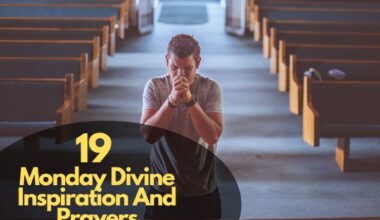Table of Contents Show
In a world evolving towards inclusivity, the question “Can A Woman Lead Prayer At Home?” resonates with the shifting dynamics of gender roles within religious practices. This article explores the historical perspectives, challenges faced, benefits of women leading prayer, and practical steps towards embracing this positive change.
Can A Woman Lead Prayer At Home?
The question of whether a woman can lead prayer at home is often influenced by religious and cultural beliefs. In many religious traditions, the permissibility of women leading prayers varies.
In Islam, for example, women are allowed to lead prayers at home. In the context of private and family settings, women can take on the role of leading prayers for themselves, their family members, or a group of women. However, in the context of congregational prayers at a mosque, the majority of Islamic scholars traditionally hold the view that women should not lead mixed-gender congregational prayers.
Historical Perspectives
Historically, religious practices have often been shaped by traditional views that limit women’s involvement in leadership roles. Cultural norms and interpretations of sacred texts have played a significant role in reinforcing these perspectives.
Instances of Women Leading Prayer in History
Despite these traditional views, history is marked by instances where women have taken on leadership roles in religious practices. Examining these historical cases sheds light on the evolving nature of women’s involvement in prayer.
Modern Interpretations
The 21st century has witnessed a notable shift in religious attitudes towards women’s participation in leadership roles. Societal changes and evolving perspectives on gender roles have influenced this transformation.
Women’s Rights and Their Impact on Religious Practices
The advocacy for women’s rights has extended to religious spheres, challenging preconceived notions and advocating for more inclusive practices. This section explores the intersection of women’s rights and religious leadership.
Cultural Variations
Cultural variations play a pivotal role in determining the acceptance of women leading prayer. This section examines how different regions and cultures approach this issue.
Cultural Factors Influencing Women’s Role in Prayer Leadership
Understanding the cultural factors that shape perceptions of women’s roles in religious practices provides valuable insights into the complexities of this debate.
Scriptural Insights
Religious texts serve as a foundation for many faiths. This section digs into the scriptural perspectives on women leading prayer and the variations in interpretations across different denominations.
Interpretation Variations Across Different Denominations
The diversity within religious denominations contributes to varying interpretations of scriptures. Exploring these differences helps in understanding the spectrum of views on women’s roles.
Challenges Faced
Women who lead prayer often face social stigmas and stereotypes. This section addresses the challenges they encounter and strategies for overcoming these barriers within religious communities.
Overcoming Barriers Within Religious Communities
Initiatives and movements aimed at breaking down barriers within religious communities are crucial for fostering inclusivity. This part highlights successful endeavors and their impact.
Empowering Women in Prayer
Various initiatives globally are working towards promoting women’s involvement in prayer leadership. This section showcases these initiatives and their role in empowering women.
Success Stories of Women Leading Prayer at Home
Real-life success stories provide inspiration and encouragement. Interviews with women who lead prayer offer insights into their experiences, motivations, and the positive changes they bring to their communities.
Personal Reflections
A personal touch is added by featuring interviews with women who lead prayer at home. Their reflections provide a glimpse into the personal and spiritual dimensions of their journey.
Insights into Their Experiences and Motivations
Understanding the experiences and motivations of these women adds depth to the narrative, fostering a connection between the readers and the individuals behind the movement.
Shaping the Future
Beyond the present, this section explores the potential long-term impact of women leading prayer at home and how it could shape the religious landscape for future generations.
Steps Towards Fostering Inclusivity in Religious Practices
Taking practical steps towards fostering inclusivity is vital. This part outlines actionable measures that can be taken to create a more inclusive religious environment.
Common Misconceptions About Women Leading Prayer
Misconceptions often surround the idea of women leading prayer. This section addresses common concerns and provides clarifications and counterarguments.
Clarifications and Counterarguments
Providing factual information and well-reasoned counterarguments helps in dispelling myths and fostering a more informed dialogue on this complex issue.
Cultural Sensitivity
Cultural sensitivity is crucial in addressing this topic. This section emphasizes the importance of respecting diverse perspectives on women’s roles in prayer leadership.
Finding Common Ground for Religious Harmony
Despite differences, finding common ground is essential for religious harmony. This part explores ways to bridge gaps and foster understanding between differing viewpoints.
Breaking Stereotypes
Stereotypes often hinder progress. This section advocates for a shift in societal perceptions towards women’s roles in prayer leadership and the broader context of leadership.
The Role of Education in Challenging Stereotypes
Education plays a pivotal role in challenging stereotypes. This part discusses the importance of educational initiatives in creating a more informed and accepting society.
Supportive Communities
Acceptance within communities is a significant factor in empowering women to lead prayer. This section explores the role of community support in breaking down barriers.
Building Networks for Women in Prayer Leadership
Creating networks and support systems is essential for women in prayer leadership. This part highlights the importance of building connections within and beyond religious communities.
The Impact on Family Dynamics
The shift towards women leading prayer also impacts family dynamics. This section explores how families navigate traditional roles while embracing progressive changes.
Positive Effects on Family Cohesion
Positive outcomes on family cohesion are explored, demonstrating how the inclusion of women in prayer leadership can strengthen familial bonds.
Conclusion
In conclusion, the question of whether a woman can lead prayer at home is deeply embedded in cultural, historical, and religious contexts. As societal norms evolve, it’s essential to navigate this discourse with respect, empathy, and a commitment to inclusivity. The stories of women leading prayer at home exemplify the transformative power of breaking down barriers and challenging stereotypes.
FAQs
Can women lead prayer in all religions?
Yes, the acceptance of women leading prayer varies across different religions and denominations. It’s essential to consider the specific beliefs and practices of each faith.
How can communities support women in prayer leadership?
Communities can support women in prayer leadership by fostering inclusive environments, providing educational resources, and challenging stereotypes within their religious circles.
What role does education play in changing perceptions?
Education plays a crucial role in challenging stereotypes and changing societal perceptions. By promoting understanding and tolerance, education contributes to a more inclusive society.








